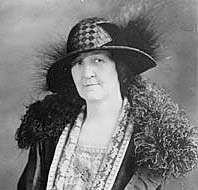MIRIAM FERGUSON
The 1924 Texas gubernatorial election was hotter than a firecrack er lit at both ends. Eight candidates vied for the democratic party’s nomination. They included Thomas D. Barton, incumbent Adjunct General of Texas; Joe Burkett, incumbent member of the Texas Senate; Vinson Allen Collins, former State Senator and member of the Ku Klux Klan; Lynch Davidson, former Lieutenant Governor of Texas; Thomas Whit- field Davidson, incumbent Lieu tenant Governor of Texas; George W. Dixon, lawyer and prison reform activist; Walter Edward Pope, former member of the Texas House of Representatives; Felix D. Robertson, incumbent Dallas County District Judge and member of the Ku Klux Klan; and Miriam A. Ferguson, former First Lady of Texas.
Miriam, affectionately known as “Ma,” was the wife of former Governor, James E. Ferguson, known as “Pa.” James ran a successful campaign for governor in 1914. While he was against prohibition, he refused to submit his name for endorsement by the anti-prohibitionists. Others who opposed banning alcohol dropped out, leaving him the winner by about 40,000 votes.
During his second term, Pa demanded that the University of Texas (UT) remove certain faculty members he found objectionable. When they refused, he vetoed most of the school’s appropriation. The cat was out of the bag—new and old charges of irregularities surfaced.
Ferguson was eventually indicted on nine charges, seven relating to the misapplication of public funds, one to embezzlement, and the other for diverting a special fund. Despite the accusations, he announced a run for a third term as governor. At that point, Pa was impeached by what he labeled a “kangaroo court.” Because he could not hold office, he ran his wife’s campaign.
Ma promised that, if elected, she would follow the advice of her husband, blessing Texans with “two governors for the price of one.” Her platform included vindication for the Ferguson name and extensive cuts in state appropriations as well as condemnation of the Ku Klux Klan and opposition to any new liquor legislation.
When the dust settled, Ms. Ferguson and Felix Robertson, the Ku Klux Klan member, were headed to a runoff. Lynch Davidson ran third, edged out by Ms. Ferguson by a mere 5,216 votes. Angry, Davidson felt he should have been in the runoff.
The La Grange Journal editor and owner, B.F. Harigel, remarked: Acknowledging defeat when the vote runs very close, is not a willing virtue with all candidates, which it might also be said, is not a bad trait. But when the vote has been tabulated and canvassed, the best and most feasible proposition is to take the dose and go down the line.
After Ms. Ferguson handily vanquished her runoff opponent 56.7 to 43.3%, the couple set their sights on the Republican contender George C. Butte. A highly educated professor at UT law school and WWI veteran, he was dean of the Law School in 192324. Republicans, the Ku Klux Klan, and unhappy Democrats coalesced around this political neophyte.
Both candidates stumped in La Grange. Butte drew three thousand to the Fayette County Courthouse lawn, where he reminded them of Ferguson’s transgressions and that Pa himself had written the Democratic platform.
A supporter of prohibition, he maintained he was never affiliated with the Klan and would take no part in the origin of hate. He vowed to be true to the oath of office.
The Democrats, who had not lost a gubernatorial election since 1874, countered with a free barbeque at the American Legion Hall. Pa spoke to an overflowing crowd, telling sup porters that voting Republican was giving aid to the Klan.
The final vote tally indicated Ms. Ferguson led 58.89% to Butte’s 41.11%, catapulting her to the dis- tinction of being the first woman governor of Texas.
The La Grange Journal opined: And what heartaches there are in some homes. If there were enough offices to be divided so as to satisfy every aspirant, no regrets would be heard, no ill feeling would follow, and things would run smooth as velvet. But it cannot always be thus.
We will have to be satisfied with the result.
Sources: La Grange Journal: August 7, 1924. October 16, 1924, October 30, 1924, and November 6, 1924 Texas State Historical Association online: George Charles Butte, James Edward Ferguson, and Miriam Amanda Wallas Ferguson Texas Almanac Online: Election of Texas Governors 1900 to 1948 Wikipedia Online: 1924 Gubernatorial Election Legislative Reference Library Online: Legislative Leaders and Governors



